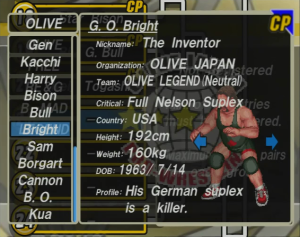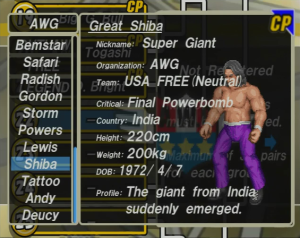MATCH 11: “THE INVENTOR” G.O. BRIGHT v. “SUPER GIANT” GREAT SHIBA
Introduction – Match 1 – Match 2 – Match 3 – Match 4 – Match 5
Match 6 – Match 7 – Match 8 – Match 9 – Match 10
We hit the next mile marker on the highway of agony as we head into match 11! TONIGHT, it’s India vs. Pakistan by way of Nebraska, as a wrestling legend takes on a legitimate giant!
G.O. BRIGHT
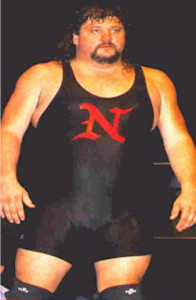 Say “G.O. Bright” fast enough, and you’ll get something that sounds like “G. Albright.” It can be no coincidence, then, that Mr. Bright bears such a striking resemblance to the late Gary Albright. As you might guess from his singlet, Gary Albright was an accomplished amateur wrestler out of the University of Nebraska, where he still holds the records for total falls in a season. It should come as no surprise, then, that Albright made his name in the UWFI, a Japanese organization that put great emphasis on making their matches look as “legitimate” as possible. Check out the end of this match between Albright and Japanese superstar Kiyoshi Tamura:
Say “G.O. Bright” fast enough, and you’ll get something that sounds like “G. Albright.” It can be no coincidence, then, that Mr. Bright bears such a striking resemblance to the late Gary Albright. As you might guess from his singlet, Gary Albright was an accomplished amateur wrestler out of the University of Nebraska, where he still holds the records for total falls in a season. It should come as no surprise, then, that Albright made his name in the UWFI, a Japanese organization that put great emphasis on making their matches look as “legitimate” as possible. Check out the end of this match between Albright and Japanese superstar Kiyoshi Tamura:
http://youtu.be/siYvarUp3dA?t=20m25s
I agree with the commentators for Russian ESPN: Albright throws one hell of a German suplex, an assertion which is corroborated by his FPWR bio. You’ll note that Albright’s bout with Tamura ended in a referee stoppage, which is a somewhat uncommon ending for a pro wrestling match. Gary was often booked to “knock out” his opponents with his impressive suplexes, giving him a reputation as “Suplex Machine.”
In the 1990s, Japanese pro wrestling was all about dropping people on their necks as hard as possible, and Albright was clearly very good at doing that. He was breaking necks and cashing checks all over Japan. This is why G.O. Bright employs the particularly nasty “full nelson suplex” as his finishing maneuver, which Albright himself utilized to great success:
http://youtu.be/nzvYs4IIuYQ?t=2m19s
FPWR categorizes Bright as an “Olive Japan” legend, paying homage to Albright’s 1995-1999 stint in All Japan Pro Wrestling, during which he was a frequent partner of our buddy Steel James. In fact, we’ve covered this before – Albright was included in All Japan’s officially licensed game. As previously noted, being officially licensed in a country with apparently no meaningful laws relating to likeness theft is a HUGE deal. We’re calling it right here: Gary Albright was BIG IN JAPAN.
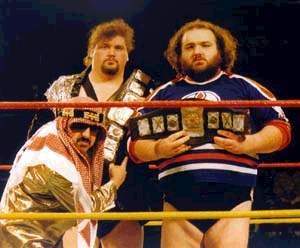 …but that’s not where this ends. You see, Albright got his start in Canada’s Stampede Wrestling, where he wrestled under the name “Vokhan Singh.” Under that moniker, Albright formed one half of the tag team “Karachi Vice.” His tag team partner? A guy named Mike Shaw (who WWF fans know as Bastion Booger), wrestling under the name “Mukhan Singh.” As our more geographically inclined readers may note, Karachi is in Pakistan. Yes, Gary Albright, a giant corn-fed white dude, was part of a Pakistani wrestling faction. So why is this relevant, you ask?
…but that’s not where this ends. You see, Albright got his start in Canada’s Stampede Wrestling, where he wrestled under the name “Vokhan Singh.” Under that moniker, Albright formed one half of the tag team “Karachi Vice.” His tag team partner? A guy named Mike Shaw (who WWF fans know as Bastion Booger), wrestling under the name “Mukhan Singh.” As our more geographically inclined readers may note, Karachi is in Pakistan. Yes, Gary Albright, a giant corn-fed white dude, was part of a Pakistani wrestling faction. So why is this relevant, you ask?
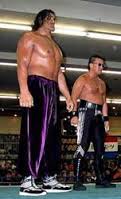 Because he’s about to take on the world’s most terrifying Indian, that’s why. Not the best time to be from Pakistan. “Great Shiba” is FPWR’s lawsuit-proof stand in for the one and only Great Khali. Shiba shares a birth year with Khali, and there’s really only one giant Indian wrestler of any repute, so we could probably end the analysis right here. But that wouldn’t be sporting, would it?
Because he’s about to take on the world’s most terrifying Indian, that’s why. Not the best time to be from Pakistan. “Great Shiba” is FPWR’s lawsuit-proof stand in for the one and only Great Khali. Shiba shares a birth year with Khali, and there’s really only one giant Indian wrestler of any repute, so we could probably end the analysis right here. But that wouldn’t be sporting, would it?
Khali, who wrestled in Japan as “Giant Singh,” has never been known for his wrestling ability, but rather his size, and nobody can argue that he didn’t succeed at being large. In the world of pro wrestling, giants serve two cardinal purposes:
- Picking up smaller people and slamming them.
- Allowing themselves to be slammed, making smaller people look impressive.
Anything else is just value added. That being said, there’s no way around it: Khali is a notoriously bad wrestler. Shiba’s finishing maneuver is a “Final Powerbomb.” Try to find video of Khali performing a powerbomb, and this will probably be your first hit:
http://youtu.be/LoeNhM3FS_w
Great googledy moogledy. That can’t really be his finishing maneuver, can it? No, of course not. Fans of Khali’s work know that he utilized a two-handed choke slam as a finisher. I can only think that FPWR‘s developers made a mistake here. Either that, or they were making a snide reference to the egregious powerbomb in the video above.
Khali did wrestle briefly in Japan. Just check out this blurry bigfoot footage we found somewhere in the ass end of YouTube:
http://youtu.be/NBMMIdyAFKo
So yes, he was BIG, and yes, he was, at one point in time, in Japan. His time in Japan lasted under a year, however, so we can’t really call him BIG IN JAPAN. Shiba isn’t going to be getting one of his tree trunks up on G.O. Bright on account of his strong Japanese fanbase.
BUUUUT… Here’s the thing. Shiba’s bio notes that he has “suddenly emerged.” Around the time of FPWR’s release, Khali had just made his WWE debut. Mere months after popping up in April of 2006, Khali rattled off victories over luminaries like Rey Mysterio, the Undertaker, and numerous others. Today, Khali is known as a bit of a goofy comedy act. Back in ’06-’07, though, he was an unstoppable monster who had yet to truly know a meaningful defeat. Nobody knew how high he would go. Great Shiba should be indicative of Khali at his theoretical maximum.
That wasn’t very funny, was it? Here’s a video of him singing
Shwew, saved.
LET’S WRESTLING
Oof. Karachi Vice my ass. Well, hopefully this settles the age-old beef between India and Pakistan. I guess when your fighting style revolves around throwing people over your head at high velocity, it helps if your opponent isn’t an 7’4″, 450 pound giant. Shiba takes it at 11:27 via a choke slam.


